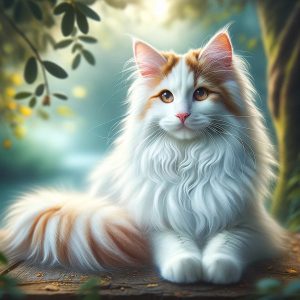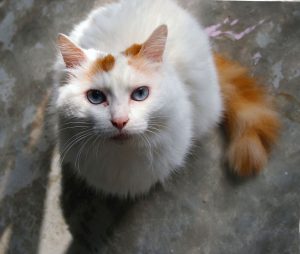The Turkish Van: A Legendary Swimmer and Elegant Companion
A Rich History: The Turkish Van’s Ancient Origins
 The Turkish Van cat breed, renowned for its love of water and distinct color pattern, has a storied history dating back to antiquity. Originating in the Lake Van region of Turkey, these cats have been companions to humans for centuries. The breed is believed to be ancient, with references to similar cats found in manuscripts and artifacts dating as far back as 5,000 years. In the 1950s, British photographers Laura Lushington and Sonia Halliday discovered these unique cats during a trip to Turkey. They were so enchanted by their distinctive appearance and behavior that they brought a pair back to Britain, marking the beginning of the Turkish Van’s introduction to the Western world. The breed was officially recognized by the International Cat Association (TICA) in 1985.
The Turkish Van cat breed, renowned for its love of water and distinct color pattern, has a storied history dating back to antiquity. Originating in the Lake Van region of Turkey, these cats have been companions to humans for centuries. The breed is believed to be ancient, with references to similar cats found in manuscripts and artifacts dating as far back as 5,000 years. In the 1950s, British photographers Laura Lushington and Sonia Halliday discovered these unique cats during a trip to Turkey. They were so enchanted by their distinctive appearance and behavior that they brought a pair back to Britain, marking the beginning of the Turkish Van’s introduction to the Western world. The breed was officially recognized by the International Cat Association (TICA) in 1985.
Unique Varieties: Types of Turkish Van Cats
While the Turkish Van breed is relatively uniform, there is some variation within the breed, primarily based on coat patterns and colors. The most iconic look is the “Van pattern,” where the cat is predominantly white with colored markings confined to the head and tail. The breed standard is strict about this pattern, which distinguishes the Turkish Van from other similarly colored cats.
Striking Appearance: The Distinctive Look of the Turkish Van
Colors: A Palette of Tradition
The Turkish Van is typically white with color patches on the head and tail. These patches can be red, cream, black, blue, and tortoiseshell. The breed is known for its “Van pattern,” which ideally leaves the body pure white.
Temperament: Lively and Affectionate
Turkish Vans are known for their energetic and playful nature. They are intelligent, curious, and enjoy interactive play. Unlike many other breeds, Turkish Vans are also known for their affinity for water, often splashing in puddles or even swimming.
Body Shape and Fur: Elegance in Every Line
Turkish Vans are medium to large cats, with males weighing between 10-20 lbs (4.5-9 kg) and females between 7-12 lbs (3-5.5 kg). They have a strong, muscular build with a broad chest and long, sturdy legs. Their heads are wedge-shaped with large, expressive eyes that can be amber, blue, or odd-eyed (one eye blue, one amber). Their ears are large and set high, giving them an alert and inquisitive expression. The fur of a Turkish Van is semi-long, silky, and water-resistant, which aids in their swimming prowess.
Personality and Behavior: A Comparison with Other Breeds
Turkish Vans are known for their active and sociable personalities. They are more energetic than many other cat breeds, often engaging in playful antics and exhibiting a strong hunting instinct. Compared to other breeds, Turkish Vans are relatively vocal, using a variety of sounds to communicate with their owners. They are also more affectionate and tend to form strong bonds with their human families, often following them from room to room.
Lifespan: Longevity of the Turkish Van
Turkish Vans are generally healthy cats with a lifespan of 12-17 years. With proper care, some can live even longer, providing many years of companionship.
Fun and Fascinating Facts: The Turkish Van’s Quirky Side
One of the most interesting aspects of the Turkish Van is its love of water, earning it the nickname “the swimming cat.” This trait is believed to have developed due to the breed’s origins near Lake Van, where they would swim to cool off during the hot summers. Another intriguing fact is their unique coat, which is said to feel like cashmere, being soft yet resistant to matting and water.
Tips for Owners: Caring for Your Turkish Van
Diet: Nutritional Needs
Turkish Vans require a high-protein diet to support their active lifestyle. Quality commercial cat food, enriched with essential nutrients, is ideal. It’s important to provide fresh water at all times, especially given their love of water play.
Grooming: Keeping That Coat Pristine
Despite their semi-long fur, Turkish Vans require minimal grooming due to their coat’s resistance to matting. Weekly brushing is usually sufficient to keep their coat looking healthy and shiny. Regular nail trimming, ear cleaning, and dental care are also recommended.
Health Considerations: Ensuring a Healthy Life

Regular veterinary check-ups are essential for maintaining the health of a Turkish Van. They are generally robust, but like all breeds, they can be prone to certain genetic conditions, so early detection and preventive care are key.
Embracing the Turkish Van: A Unique and Joyful Companion
The Turkish Van is a delightful blend of beauty, intelligence, and playful energy. Their unique history, striking appearance, and engaging personality make them a standout choice for cat enthusiasts. With proper care, they can be a loyal and entertaining addition to any household, bringing joy and companionship for many years. Whether you are captivated by their swimming antics or their affectionate nature, the Turkish Van is a breed that truly stands out.
Leave a Reply